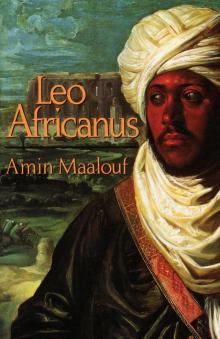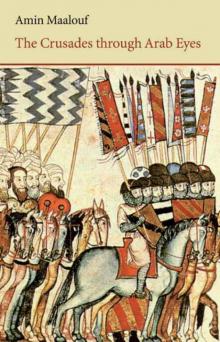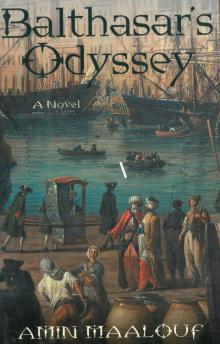- Home
- Amin Maalouf
The Crusades Through Arab Eyes Page 3
The Crusades Through Arab Eyes Read online
Page 3
The emir Chaka had devised a coherent plan in pursuit of this goal. First he left Constantinople to settle in Smyrna, on the Aegean Sea. There, with the aid of a Greek shipbuilder, he constructed a fleet of his own, including light brigantines and galleys, dromonds, biremes, and triremes—nearly a hundred vessels in all. During the initial phase of his campaign, he occupied many islands, in particular Rhodes, Chios, and Samos, and established his authority along the entire Aegean coast. Having thus carved out a maritime empire, he proclaimed himself basileus, organizing his Smyrna palace on the pattern of the imperial court. He then launched his fleet in an assault on Constantinople. Only after enormous effort did Alexius manage to repel the attack and destroy a part of the Turkish vessels.
Far from discouraged, the father of the future sultana set to work to rebuild his warships. By then it was late 1092, just when Kilij Arslan was returning from exile, and Chaka calculated that the young son of Süleymān would be an excellent ally against the Rūm. He thus offered him the hand of his daughter. But the calculations of the young sultan were quite different from those of his father-in-law. He saw the conquest of Constantinople as an absurd project; on the other hand, all in his entourage were aware of his intention to eliminate the Turkish emirs who were then seeking to carve out fiefdoms for themselves in Asia Minor, in particular Danishmend and the ambitious Chaka. The sultan did not hesitate: a few months after the arrival of the Franj, he invited his father-in-law to a banquet, plied him with drink, and stabbed him to death, with his own hand it appears. Chaka was succeeded by a son who possessed neither his father’s intelligence nor his ambition. The sultana’s brother was content to administer his maritime emirate until one day in 1097 when the Rūm fleet arrived unexpectedly off the coast of Smyrna with an equally unexpected messenger on board: his own sister.
She was slow to realize the reasons for the Byzantine emperor’s solicitude towards her, but as she was being led to Smyrna, the city in which she had spent her childhood, everything suddenly became clear. She was told to explain to her brother that Alexius had taken Nicaea, that Kilij Arslan had been defeated, and that a powerful army of Rūm and Franj would soon attack Smyrna, supported by an enormous fleet. In exchange for his life, Chaka’s son was invited to lead his sister to her husband, somewhere in Anatolia.
Once this proposition was accepted, the emirate of Smyrna ceased to exist. With the fall of Nicaea, the entire coast of the Aegean Sea, all the islands, and the whole of western Asia Minor now stood beyond the control of the Turks. And the Rūm, with the aid of their Frankish auxiliaries, seemed determined to press on further.
In his mountain refuge, however, Kilij Arslan did not lay down his arms.
Once he had recovered from the surprise of the first few days, the sultan began actively preparing his riposte. ‘He set about recruiting troops and enrolling volunteers, and proclaimed jihād’, notes Ibn al-Qalānisi.
The Damascene chronicler adds that Kilij Arslan ‘asked all Turks to come to his aid, and many of them answered his call.’
In fact, the sultan’s prime objective was to cement his alliance with Danishmend. A mere truce was no longer enough: it was now imperative that the Turkish forces of Asia Minor unite, as if forming elements of a single army. Kilij Arslan was certain of his rival’s response. A fervent Muslim as well as a realistic strategist, Danishmend felt threatened by the advance of the Rūm and their Frankish allies. He preferred to confront them on his neighbour’s lands rather than on his own, and without further ado he arrived in the sultan’s camp, accompanied by thousands of cavalry. There was fraternization and consultation, and plans were drafted. The sight of this multitude of warriors and horses blanketing the hills filled the commanders with fresh courage. They would attack the enemy at the first opportunity.
Kilij Arslan stalked his prey. Informers who had infiltrated the Rūm brought him precious information. The Franj openly proclaimed that they were resolved to press on beyond Nicaea, and that their real destination was Palestine. Even their route was known: they would march in a south-easterly direction towards Konya, the only important city still in the hands of the sultan. During their entire trek through this mountainous zone, the flanks of the Occidental army would be vulnerable to attack. The only problem was to select the proper site for the ambush. The emirs, who knew the region well, had no hesitation. Near the city of Dorylaeum, four days’ march from Nicaea, there was a place at which the road narrowed to pass through a shallow valley. If the Turkish warriors gathered behind the hills, all they would have to do was bide their time.
By the last days of June 1097, when Kilij Arslan learned that the Occidentals had left Nicaea, accompanied by a small force of Rūm, the apparatus for the ambush was already in position. At dawn on 1 July the Franj loomed onto the horizon. Knights and foot-soldiers advanced serenely, seemingly with no idea of what was in store for them. The sultan had feared that his stratagem might be discovered by enemy scouts. Apparently, he had nothing to worry about. Another source of satisfaction for the Seljuk monarch was that the Franj seemed less numerous than had been reported. Had some of them perhaps remained behind in Nicaea? He did not know. At first sight, however, he seemed to command numerical superiority. This, combined with the element of surprise, augured well. Kilij Arslan was anxious, but confident. The wise Danishmend, with his twenty more years of experience, felt the same.
The sun had barely risen from behind the hills when the order to attack was given. The tactics of the Turkish warriors were well practised. After all, they had assured their military supremacy in the Orient for half a century. Their army was composed almost exclusively of light cavalry who were also excellent archers. They would draw near, unleash a flood of deadly arrows on their enemy, and then retreat briskly, giving way to a new row of attackers. A few successive waves usually sufficed to bring their prey to their death agony. It was then that the final hand-to-hand combat was joined.
But on the day of the battle of Dorylaeum, the sultan, ensconced with his general staff atop a promontory, noted anxiously that the tried-and-true Turkish methods seemed to lack their usual effectiveness. Granted, the Franj lacked agility and seemed in no hurry to respond to the repeated attacks, but they were perfect masters of the art of defence. Their army’s main strength lay in the heavy armour with which their knights covered their entire bodies, and sometimes those of their mounts as well. Although their advance was slow and clumsy, their men were magnificently protected against arrows. On that day, after several hours of battle, the Turkish archers had inflicted many casualties, especially among the foot-soldiers, but the bulk of the Frankish army remained intact. Should they engage the hand-to-hand combat? That seemed risky: during the many skirmishes around the field of battle, the horsemen of the steppes had come nowhere near holding their own against these virtual human fortresses. Should the phase of harassment be prolonged indefinitely? Now that the element of surprise had worn off, the initiative might well shift to the other side.
Some of the emirs were already counselling retreat when a cloud of dust appeared in the distance. A fresh Frankish army was approaching, as numerous as the first. Those against whom the Turks had been fighting all morning turned out to be only the vanguard. Now the sultan had no choice but to order a retreat. Before he could do so, however, a third Frankish army came into view behind the Turkish lines, on a hill overlooking the tent of the general staff.
This time Kilij Arslan succumbed to fear. He leapt onto his charger and headed for the mountains at full gallop, even abandoning the rich treasure he carried with him to pay his troops. Danishmend was not far behind, along with most of the emirs. Taking advantage of their one remaining trump card, speed, many horsemen managed to get away without the victors’ being able to give chase. But most of the soldiers remained where they were, surrounded on all sides. As Ibn al-Qalānisi was later to write: The Franj cut the Turkish army to pieces. They killed, pillaged, and took many prisoners, who were sold into slavery.
During his fligh
t, Kilij Arslan met a group of cavalry coming from Syria to fight at his side. They were too late, he told them ruefully. The Franj were too numerous and too powerful, and nothing more could be done to stop them. Joining deed to word, and determined to stand aside and let the storm pass, the defeated sultan disappeared into the immensity of the Anatolian plateau. He was to wait four years to take his revenge.
Nature alone seemed still to resist the invader. The aridity of the soil, the tiny mountain pathways, and the scorching summer heat on the shadowless roads slowed the advance of the Franj. After Dorylaeum, it took them a hundred days to cross Anatolia, whereas in normal times a month should have sufficed. In the meantime, news of the Turkish debacle spread throughout the Middle East. When this event, so shameful for Islam, became known, noted the Damascene chronicler, there was real panic. Dread and anxiety swelled to enormous proportions.
Rumours circulated constantly about the imminent arrival of redoubtable knights. At the end of July there was talk that they were approaching the village of al-Balana, in the far north of Syria. Thousands of cavalry gathered to meet them, but it was a false alarm: there was no sign of the Franj on the horizon. The most optimistic souls wondered whether the invaders had perhaps turned back. Ibn al-Qalānisi echoed that hope in one of those astrological parables of which his contemporaries were so enamoured: That summer a comet appeared in the western sky; it ascended for twenty days, then disappeared without a trace. But these illusions were soon dispelled. The news became increasingly detailed. From mid-September onwards, the advance of the Franj could be followed from village to village.
On 21 October 1097 shouts rang out from the peak of the citadel of Antioch, then Syria’s largest city: ‘They are here!’ A few layabouts hurried to the ramparts to gawk, but they could see nothing more than a vague cloud of dust far in the distance, at the end of the broad plain, near Lake Antioch. The Franj were still a day’s march away, perhaps more, and there was every indication that they would want to stop to rest for a while after their long journey. Nevertheless, prudence demanded that the five heavy city gates be closed immediately.
In the souks the morning clamour was stilled, as merchants and customers alike stood immobile. Women whispered, and some prayed. The city was in the grip of fear.
2
An Accursed Maker of Armour
When Yaghi-Siyān, the ruler of Antioch, was informed of the approach of the Franj, he feared possible sedition on the part of the Christians of the city. He therefore decided to expel them.
This event was related by the Arab historian Ibn al-Athīr, more than a century after the beginnings of the Frankish invasion, on the basis of testimony left by contemporaries:
On the first day, Yaghi-Siyān ordered the Muslims to go out beyond the walls to clean out the trenches ringing the city. The next day, he sent only Christians on the same task. He had them work until night had fallen, and when they sought to return, he halted them, saying, ‘Antioch is your city, but you must leave it in my hands until I have resolved our problem with the Franj.’ They asked him, ‘Who will protect our women and children?’ The emir answered, ‘I will take care of them for you.’ He did, indeed, protect the families of those expelled, refusing to allow anyone to touch a hair of their heads.
In that October of 1097 the aged Yaghi-Siyān, for forty years an obedient servant of the Seljuk sultan, was haunted by the fear of betrayal. He was convinced that the Frankish armies gathered before Antioch would be able to enter the city only if they found accomplices within the walls. For the city could not be taken by assault, and still less starved out by a blockade. Admittedly, this white-bearded Turkish emir commanded no more than six or seven thousand soldiers, whereas the Franj had nearly thirty thousand combatants, but Antioch was practically impregnable. Its walls were two farsakh long (about twelve thousand metres), and had no less than 360 turrets built on three different levels. The walls themselves, solidly constructed of stone and brick on a frame of masonry, scaled Mount Ḥabīb al-Najjar to the east and crowned its peak with an inexpugnable citadel. To the west lay the Orontes, which the Syrians called al-Assi, ‘the rebel river’, because it sometimes seemed to flow upstream, from the Mediterranean to the interior of the country. The river-bed ran along the walls of Antioch, forming a natural obstacle not easily crossed. In the south, the fortifications overlooked a valley so steep that it seemed an extension of the city walls. It was therefore impossible for attackers to encircle the city, and the defenders would have little trouble communicating with the outside world and bringing in supplies.
The city’s food reserves were unusually abundant; the city walls enclosed not only buildings and gardens, but also wide stretches of cultivated land. Before the Fatḥ, or Muslim conquest, Antioch was a Roman metropolis of two hundred thousand inhabitants. By 1097 its population numbered only some forty thousand, and several formerly inhabited quarters had been turned into fields and pastures. Although it had lost its past splendour, it was still an impressive city. All travellers, even those from Baghdad or Constantinople, were dazzled by their first sight of this city extending as far as the eye could see, with its minarets, churches, and arcaded souks, its luxurious villas dug into the wooded slopes rising to the citadel.
Yaghi-Siyān was in no doubt as to the solidity of his fortifications and the security of his supplies. But all his weapons of defence might prove useless if, at some point along the interminable wall, the attackers managed to find an accomplice willing to open a gate to allow them access to a turret, as had already happened in the past. Hence his decision to expel most of his Christian subjects. In Antioch as elsewhere, the Christians of the Middle East—Greeks, Armenians, Maronites, Jacobites—suffered a double oppression with the arrival of the Franj: their Western coreligionists suspected them of sympathy for the Saracens and treated them as subjects of inferior rank, while their Muslim compatriots often saw them as natural allies of the invaders. Indeed, the boundary between religious and national affiliation was practically non-existent. The same term, ‘Rūm’, was used to refer to both Byzantines and Syrians of the Greek confession, who in any event still saw themselves as subjects of the basileus. The word ‘Armenian’ referred to a church and a people alike, and when a Muslim spoke of ‘the nation’, al-umma, he was referring to the community of believers. In the mind of Yaghi-Siyān, the expulsion of the Christians was less an act of religious discrimination than a wartime measure against citizens of an enemy power, Constantinople, to which Antioch had long belonged and which had never renounced its intention of recovering the city.
Antioch was the last of the great cities of Arab Asia to have fallen under the domination of the Seljuk Turks: in 1084 it was still a dependency of Constantinople. Thirteen years later, when the Frankish knights laid siege to the town, Yaghi-Siyān was naturally convinced that this was part of an attempt to restore the authority of the Rūm, with the complicity of the local population, the majority of whom were Christians. Faced with this danger, the emir was not troubled by any scruples. He therefore expelled the nazara, the adepts of the Nazarethan (for this is what Christians were called), and then took personal charge of the rationing of grain, oil, and honey, ordering daily inspections of the fortifications and severely punishing any negligence. Would that suffice? Nothing was certain. But these measures were designed to enable the city to hold out until reinforcements arrived. When would they come? The question was asked insistently by everyone in Antioch, and Yaghi-Siyān was no more able to give an answer than was the man in the street. Back in the summer, when the Franj were still far away, he had dispatched his son to visit the various Muslim leaders of Syria to alert them to the danger stalking his town. Ibn al-Qalānisi tells us that in Damascus Yaghi-Siyān’s son spoke of holy war. But in Syria in the eleventh century, jihād was no more than a slogan brandished by princes in distress. No emir would rush to another’s aid unless he had some personal interest in doing so. Only then would he contemplate the invocation of great principles.
Now,
in that autumn of 1097, the only leader who felt directly threatened by the Frankish invasion was Yaghi-Siyān himself. If the emperor’s mercenaries wanted to recover Antioch, there was nothing unnatural about that, since the city had always been Byzantine. In any case, it was thought that the Rūm would go no further. And it was not necessarily bad for his neighbours if Yaghi-Siyān was in a spot of trouble. For ten years he had toyed with them, sowing discord, arousing jealousy, overturning alliances. Now he was asking them to put their quarrels aside and rush to his aid. Why should he be surprised if they failed to come at the run?
A realistic man, Yaghi-Siyān was well aware that he would be left to languish and forced to beg for help, that he would now have to pay for his past cleverness, intrigue, and betrayal. But he never imagined that his coreligionists would go so far as to hand him over, bound hand and foot, to the mercenaries of the basileus. After all, he was merely struggling to survive in a merciless hornets’ nest. Bloody conflict was relentless in the world in which he had grown up, the world of the Seljuk Turks, and the master of Antioch, like all the other emirs of the region, had no choice but to take his stand. If he wound up on the losing side, his fate would be death, or at least imprisonment and disgrace. If he was lucky enough to pick the winning side, he would savour his victory for a time, and receive several lovely female captives as a bonus, before once again finding himself embroiled in some new conflict in which his life was at stake. Survival in such a world depended above all on backing the right horse, and on not insisting on the same horse at all times. Any mistake was fatal, and rare indeed was the emir who died in bed.

 Samarkand
Samarkand Leo Africanus
Leo Africanus The Disoriented
The Disoriented The Crusades Through Arab Eyes
The Crusades Through Arab Eyes Balthasar's Odyssey
Balthasar's Odyssey